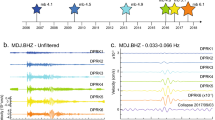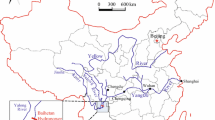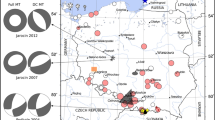Summary.
Studies of source mechanisms of mining-induced seismic events play an important role in understanding the various modes of failure observed around underground excavations and enable the geometry of likely planes of failure to be determined. These planes can be mapped using conventional techniques, for example, geological fracture mapping. However, such an approach is often problematical due to limited access to the site and/or poor exposures (if any) of the failure plane. An added difficulty is that planes of failure often do not follow faults of geological origin, but are related to the geometry of the advancing stope face. For example, the development of face-parallel shear zones ahead of deep-level stope faces. In such cases, the stresses induced by mining dominate over the geological structure in the critical region close to the stope face. Seismic methods therefore have the potential of being a practical method of studying the development of seismic shear zones underground.
Slip on such a failure plane generates a three dimensional elastic wave that propagates through the rockmass, carrying a wealth of information regarding the source rupture process. The ground motions caused by the passage of the wave can be recorded by arrays of sensitive instruments called seismometers. These sets of recordings (seismograms) provide the basic data that seismologists use to study these elastic waves as they propagate through the Earth. Conventional seismic analyses provide scalar measurements of the rupture size and intensity. However, through a process known as moment tensor inversion (MTI), the seismograms recorded from a seismic event can be used to calculate a moment tensor that describes the three dimensional nature of the source mechanism. Interpretation of the moment tensor gives insight into whether the rockmass failed in tension, compression or shear and indicates the direction of movement and the failure plane.
Moment tensor solutions computed using conventional MTI methods are sensitive to noise and may be biased due to systematic errors in the measurements. The primary objective of this study was to develop a robust MTI method to estimate the moment tensors of clusters of seismic events recorded in the underground environment. To achieve this, three ‘hybrid’ MTI methods were developed by the author. These methods involve different iterative weighting schemes designed to enhance the accuracy of the computed moment tensors by decreasing the effect of outliers (data points whose residuals lie ‘far’ from the mean or median error). The additional information required for hybrid methods is obtained by considering a spatial cluster of seismic events and assuming that the waves generated by each event in the cluster follow a similar path through the rockmass and allowing a common ray-path to be assumed. Hence the unknown effect of the heterogeneous rockmass on the waveform is similar for all the events in the cluster.
The final objective was to determine whether the techniques developed could be successfully applied to real data. The hybrid MTI methods using the median and the weighted mean correction were applied to a cluster of 10 events, having remarkably similar waveforms, recorded at Oryx Gold Mine. For comparative purposes, the more conventional absolute method was also applied. The solutions computed using the hybrid MTI with a median correction displayed a distinct improvement after the iterative residual correction procedure was applied, in contrast to the solutions obtained from the absolute method. The radiation patterns and fault-plane solutions from the hybrid method showed a high degree of similarity, and were probably more accurate reflections of reality. These observations are very encouraging and point towards the potential for using the hybrid MTI method with a median correction as a standard processing tool for mine seismicity.
The implications of this work are that a robust method for calculating the focal mechanisms of clusters of seismic events induced by mining activities has been developed. Regular application will lead to a better understanding of rock fracture processes and to improved safety underground.
Similar content being viewed by others
Author information
Authors and Affiliations
Rights and permissions
About this article
Cite this article
Linzer, L. A Relative Moment Tensor Inversion Technique Applied to Seismicity Induced by Mining. Rock Mech. Rock Engng. 38, 81–104 (2005). https://doi.org/10.1007/s00603-004-0041-4
Received:
Accepted:
Published:
Issue Date:
DOI: https://doi.org/10.1007/s00603-004-0041-4




